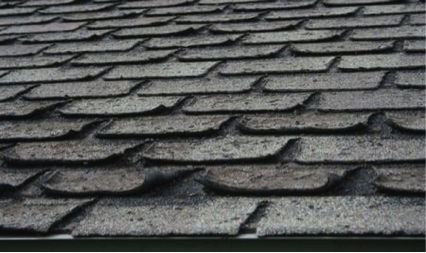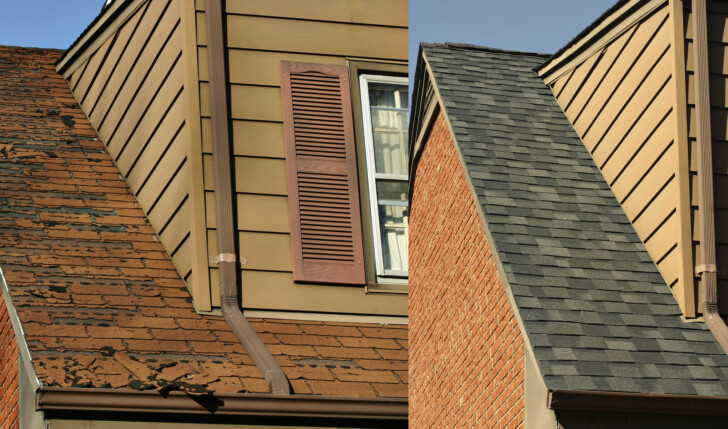Did you know? According to a 2023 study by the National Roofing Contractors Association (NRCA), around 40% of homeowners who delay roof repairs end up facing additional issues such as structural damage and higher repair costs. This highlights just how critical it is to address roofing problems promptly to avoid escalating expenses and more extensive damage.
1. Visible Wear and Tear

Visible wear and tear on your roof is a clear indication that it’s time to consider a remodel. Cracked or curling shingles are often the first signs of deterioration, as they compromise the roof’s ability to shed water properly. Missing shingles can leave parts of your roof exposed to the elements, increasing the risk of leaks and further damage. Granule loss, where small, protective particles from the shingles end up in your gutters, also signals wear and reduces the shingles’ ability to protect against UV rays. These signs not only affect the aesthetic appeal of your home but more importantly, they indicate that your roof may no longer be effectively shielding your home from water and weather damage. Addressing these issues promptly is crucial to maintaining the integrity of your home and preventing more extensive and costly repairs.
2. Leaks and Water Damage

Leaks and water damage are serious red flags that your roof might need immediate attention. If you notice water stains on your ceilings or walls, damp spots in your attic, or musty odors, these are strong indicators that water is infiltrating your home. Persistent leaks can compromise the structural integrity of your home, leading to rotting wood, weakened beams, and damaged insulation. Beyond structural damage, ongoing moisture problems can create a breeding ground for mold and mildew, which not only pose health risks but also lead to expensive remediation efforts. Addressing leaks quickly is essential to prevent further damage and to protect both your home and your health.
What It Promotes:
- Structural damage and deterioration
- Mold and mildew growth
- Increased health risks
- Higher repair and remediation costs
3. Increased Energy Bills
Noticing a spike in your heating or cooling bills? It might be more than just a seasonal change. According to the U.S. Department of Energy, up to 30% of your home’s energy can be lost due to poor roof insulation and ventilation. To put that in perspective, if your monthly energy bill is $200, you could be wasting up to $60 each month—over $700 a year—just due to roofing inefficiencies. This added cost comes from having to overwork your HVAC system to keep your home comfortable. Fixing roof insulation and ventilation issues can lead to significant savings on your energy bills and make your home more energy-efficient.
What It Promotes:
- Increased energy consumption
- Higher utility bills
- Greater strain on HVAC systems
- Reduced overall energy efficiency
4. Age of Your Roof

Even if your roof looks fine from the outside, its age can be a crucial factor in its overall reliability. Most roofs are designed to last between 20 and 25 years. Once your roof reaches this age, it becomes increasingly vulnerable to problems like leaks and deterioration, even if there are no obvious signs of damage. Materials naturally break down over time, and an old roof may not perform as well as it used to, leaving your home exposed to potential issues and making it more prone to costly repairs. Regular inspections and timely replacement are key to avoiding unexpected problems and maintaining the integrity of your home.
5. Shingle Granule Accumulation in Gutters
If you see a lot of small granules from your shingles in your gutters, it’s a warning sign. These granules help protect your shingles from the sun’s UV rays. When they start washing away, it means your shingles are wearing out and losing their protective abilities. This can lead to serious problems like leaks and a shorter lifespan for your roof.
 6. Roof Sagging or Dips
6. Roof Sagging or Dips
If you notice uneven rooflines or visible sagging, it’s a major red flag. These dips often point to underlying structural problems with the roof’s support system. The sagging indicates that the roof might not be holding up as it should, which could mean that the framework supporting your roof is compromised.
Ignoring these signs can lead to more severe issues. A roof that’s not structurally sound can result in further damage, including leaks and potential collapse. Addressing sagging early can help prevent costly repairs and ensure that your roof remains safe and reliable.
7. Moss and Algae Growth
Moss, algae, and lichens on your roof might look harmless, but they can be a real nightmare. These growths trap moisture against your roof, creating a damp environment that accelerates wear and tear. Over time, this constant moisture can lead to the breakdown of roofing materials, making your roof less effective at protecting your home.
Not only do these growths weaken your roof’s integrity, but they can also cause shingles to lift and crack. This can lead to leaks and other serious issues. Addressing moss and algae growth promptly is crucial to maintaining the longevity and performance of your roof.
 Understanding these signs can help you determine when it’s time for a roof remodel. Addressing issues early can save you from more significant problems and costs down the line.
Understanding these signs can help you determine when it’s time for a roof remodel. Addressing issues early can save you from more significant problems and costs down the line.



